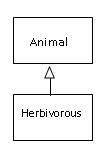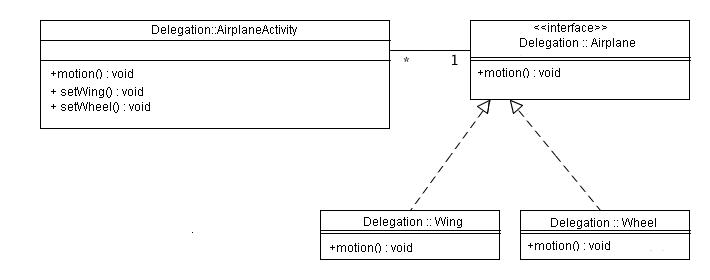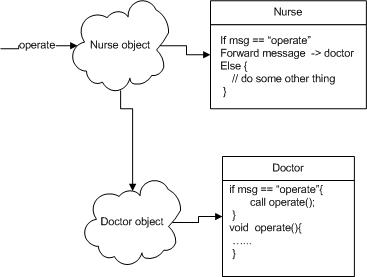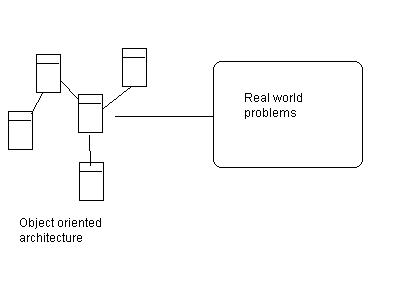CSC/ECE 517 Fall 2010/ch3 S30 PS
Decomposition, Message Forwarding, and Delegation versus Inheritance in OOP Design
Introduction
Object Oriented Programming concentrates on the design of a system using objects as individual entities which has different states and behaviors. These objects interact with each other to form the system. Object Oriented Design (OOD) refers to the process of deciding the objects and the level of interaction between these.
Object Oriented Approach has advantages such as the code is easy to maintain and it can be reused. Thus it ensures minimal duplication of code in your system and improves the quality of the software. When we think of object oriented programming, the Inheritance, Encapsulation, Polymorphism feature attracts our attention. However, there are many other alternatives to the traditional inheritance such as Delegation, Message Forwarding and decomposition. Inheritance is the mechanism by which we can extract the common functionality between hierarchical classes, hence a method can be implemented only once in a hierarchical class system and can be accessed through it descendant. Delegation deals with passing the execution of program to another class at run time. With the help of Message Forwarding an object can communicate with other objects by sending and receiving messages. Decomposition is the technique of breaking a task into smaller parts so that they can be easily implemented and managed.
In this chapter, we will be first explaining the concept of Inheritance. Further, we will be contrasting it with Delegation, Message Forwarding and Decomposition.
Inheritance
Inheritance is a powerful concept in object oriented programming which allows code reusability. In this the functionality of the base class can be inherited by its subclasses. At the same time subclass can have its own functionality.
There two types of inheritance
Single Inheritance
This property restricts that a class can only inherit from one class. Java and Ruby are examples of object-oriented languages that have single inheritance.
Multiple Inheritance
This property allows a single class to inherit functionality from multiple classes. C++ allows Multiple Inheritance, however, the major drawback of this property is that it leads to the classical Diamond Multiple Inheritance Problem.
The concept of Inheritance can be better explained with a code in Ruby. In ruby we have single Inheritance.
Example in Ruby
class Animal
def sleep
puts " I want to sleep "
end
end
class Herbivorous < Animal
def eat
puts " I want to eat plants "
end
end
Code execution
MyAnimal = Herbivorous.new MyAnimal.sleep #I want to sleep MyAnimal.eat #I want to eat plants
Here the class Herbivorous inherits the class Animal. So when we create an object of the Herbivorous class we are able to inherit methods from the Animal class. Here is the simple UML diagram to explain inheritance.

When to use inheritance
- Inheritance is used when there is an IS-A relationship between two classes. For example, Herbivorous is-an Animal.
- When code re-usability is desired.
- Inheritance is used when sub categories can be created from complex class.
Delegation
As the word suggest, delegation means assign the task to some other entity. In object oriented programming terminology it an be explained as, process of implementation of one method to other method in different class. Delegation is also called as dynamic inheritance.
When two objects are not of the same type, let’s say there are two objects A and B, A has some method and attributes, which B is interested in using. Then, using delegation technique, This mechanism can be suitable where we have to decide at run time based on the user input, which functionality needs to be executed.
Code example in Ruby
module Airplane
def motion
raise NotImplementedError.new
end
end
class Wheel
include Airplane
def motion
puts " Performs circular motion."
end
end
class Wing
include Airplane
def motion
puts "Performs Vertical motion"
end
end
class AirplaneActivity
include Airplane
def initialize
@var = Wing.new
end
def motion
@var.motion
end
def setWing
@var = Wing.new
end
def setWheel
@var = Wheel.new
end
end
The above Ruby example creates a class Airplane which has method motion in it. This method throws NotImplementedError which indicates that there is not definition for this method. The classes Wheel,Wing and AirplaneActivity includes the class Airplane in their definition and overrides the motion method. In the class AirplaneActivity, we provide the initialize method, which initializes the instance variable to an object of class Wing. Also the methods setWing and setWheel in the sets the different object values for instance variable @var.
obj = AirplaneActivity.new obj.motion # output => "Performs Vertical motion" obj.setWheel # create new object of Wheel class obj.motion # output => "Performs Circular motion"
The above code is a sample test code which will reveal the Delegation behavior. In the first like we have created an object obj of class AirPlaneActivity. This calls the initialized method and creates a Wing class object. Next line executes motion method of class AirPlaneActivity which calls motion method of Wing class. This is possible because the current value of @var points to object of Wing class. In the third line, using setWheel, the @var value is set to Wheel's object. Due to this the motion method of Wheel class will get invoked. In this way, motion method of AirPlaneActivity class delegates control to different motion method of Wing and Wheel class based on the value of @var instance variable.

Above UML diagram shows how the delegation pattern looks like and how the behaviors be composed at the run-time. It also shows how all the classes are related to each other.
Delegation Vs. Inheritance
- Delegation is used when there is HAS-A relationship between two object. For example, Airplane has engine and wings. Relationship between all these three classes depict the HAS-A relationship. Based on which activity to be monitored, corresponding motion() method is invoked. This is not the case with the inheritance, to get the slightly different functionality, we have to over write the existing method.
- Delegation should be used when there the two objects are of the different type but has some what similar functionality.
- Delegation can be used where components that behave identically, but this situation may change over the time.
- Delegation leverage loose coupling in the components and hence the alteration of one component does not affect the system much. In the inheritance, on the other hand, there is a tight coupling between parent class and its children hence modification in parents functionality may lead logical error in all its children.
- Delegation is sometimes called as dynamic inheritance as the binding happens at run time. In the above example, based on the object, corresponding methods are invoke. This not the case with inheritance as its is determined at the compile time.
Pitfalls of delegation
- Delegation increases the code size as compared to inheritance. In above code also we have written one interface and three classes to make delegation work.
Message Forwarding
In object oriented programming, message forwarding is one of the most powerful techniques. In this, when a message is sent to an object and if that object does not process that particular method, then instead of displaying error, receiving object gets a second chance to process a message.
SmallTalk and Objective-C supports this mechanism.
Let’s look at the simple example for message forwarding. Lets say we have two classes ‘Nurse’ and ‘Doctor’.

In the above example, when the message for ‘operate’ comes to the Nurse, it does not handle that messages as ‘Nurse don’t do operations alone and has to be done by doctor.’ Hence instead of giving a error, it forwards that message along with input parameters to the ‘Doctor’ object. Doctor object handles the operate method and return the response to the Nurse object. From the abstract view, it appears that Nurse object is only handling the message but in real, Doctor’s object working on it. Message forwarding simulates multiple inheritances in object oriented programming as object that forwards message can inherits method from its super class and the class where it is forwarding the method. In other words, Nurse inherits functionality from its super class and Doctor class.
For selection of different objects to forward the message, observer design pattern is used. Languages like objective-C have extensive support for message forwarding. To implement this, observer design pattern is used. There are four parts to a message: a receiver object, a method name, optional method arguments, and an optional return value are to be handled.
Code example – objective -C
id newObject; // could be any object;
newObject = [[NewObject alloc] init]; // create and initialize the object
[newObject doSomethingWith: anotherObject]; // send it a message.
- (void) forwardInvocation: (NSInvocation*)anInvocation
{
if ([anObject respondsToSelector: [anInvocation selector]])
return [anInvocation invokeWithTarget: anObject];
else
return [self doesNotRecognizeSelector: [anInvocation selector]];
}
In the above code, newObject is an object and doSomethingWith is a method definition which unknown to newObject. As the message to object binding happens at run-time, compiler will still compile the code. At run-time objective-C will find out that newObject did not recognize the doSomethingWith: message. Instead of giving error, the runtime sends another message to newObject as forwardInvocation: message. Now if the newObject know the anObject then it will forward. Self here refers to the object which get the message, in the case its newobject.
Message forwarding can also be simulated from other objected oriented languages.
Example using JavaScript
// This code will instantiated object 'receiver'
// and call method 'receivingFunction'
var receiver = new someClass();
m(receiver, 'receivingFunction', someArgument);
// object implements 'forwardInvocation' to send the message
// to next object.
var class1 = new Class({
forwardInvocation: function(){
return object2; // Forwarding
}
});
var class2 = new Class({
forwardInvocation: function(){
return object3; // Forwarding
}
});
var class3 = new Class({
receivingFunction: function(){
return 'Message received.' //Actual message
}
});
object1 = new class1();
object2 = new class2();
object3 = new class3();
alert(m(object1, 'receivingFunction'));
In the above code, alert message will send a message to obejct1 for handling 'receivingFunction'. As object1 does not handle it, it will send message to object2 and so on till actual function gets called. To this we have to implement 'forwardInvocation' method for forwarding the message.
This code is referred from this article.
Message forwarding Vs. Inheritance
- Message forwarding is leverage the functionality of reusing the code of some other class. This functionality cannot be implemented using inheritance as code reuse is done only in the inheritance hierarchy and not beyond that.
- Compared to inheritance, message forwarding provides privilege of loosely coupled design as the different objects can communicate via exchange of massages. In inheritance, there is always a tight coupling .
- This helps data to be sent to objects of different classes in a very efficient manner. Languages like objective –C or SmallTalk have specific methods to implement this. Also message forwarding can be simulated with other object oriented languages like Java , Ruby and many more.
- The change of a state in one object must be reflected in another object without keeping the objects tight coupled.
- In inheritance, if we want custom implementation, then we have to override the method to provide new functionality. In this we cannot change the method prototype. If user wants to change prototype of the method, then all the overridden methods have to change the prototypes. In contrast to that, with the help of message forwarding, we can avoid this situation as the messages are getting passed to other object, hence no dependencies.
Pitfalls in Message forwarding
- In message forwarding, each argument have to allocate extra memory, however in inheritance, as derived class object at call of it parent object only reference to the arguments are passed. As an example, if a big string (around 2000 characters) to be passed as an argument, that much memory has to be allocated. However, in inheritance as all the objects are tightly coupled, sending the object reference is enough.
Decomposition
Decomposition follows the divide and conquer strategy which help to solve any complex problem. In object oriented terminology, it is a method of breaking down bigger problem or system into smaller classes and object which gives clear understanding of its functionality. The different part after decomposition of the systems interacts with each other through well defined interfaces.
In non-object oriented languages such as C, the large systems can be broken down by writing different functions. This is called as functional decomposition. however due to different functions there is tight coupling between all the methods. Hence,if the implementation of one of the function changes, all the other functions which are dependent on this function also need to changed.
To avoid this problem, Decomposition in object-oriented OOP design is preferred. In this, we create well defined objects, who interacts with each other through well defined interfaces. If the implementation in one of the object changes then, only two objects between which the interaction takes place needs to be changed. In sum, due to changes in one of the objects we do not affect a larger portion of the system.

For better understanding lets consider the above airplane system example. The airplane consists of wheel, wings, propellers, cockpit, etc.In Object Oriented Decomposition we create objects of these classes. Also we create an object Controller which interacts with all these objects and is responsible for the overall functioning the system. Now if there is a problem with the wheel, this does not affect the functionality of other objects. Only the central controller and the wheel need to implement the necessary changes. This does not affect the functionality of other objects.
Inheritance vs Decomposition
- In object oriented programming multiple inheritances plays an important role. Languages like C++ allowed multiple inheritances. In the industries, to implement large systems this property is used frequently. However due to well known diamond problem for multiple inheritances and complex hierarchy of the classes programmers finds less visibility of the functionality in inheritance tree. Hence decomposition is considered as a solution to these problems. To solve these issues many researchers such are working on finding reliable algorithms to decompose the large inheritance based hierarchical systems. M. Habib, M. Huchard and J. Spinrad have covered this aspects in their paper named A Linear Algorithm To Decompose Inheritance Graphs Into Modules
- In Inheritance we need to define methods in the Super class which can be used by the objects in sub class. This can be achieved by using the extends functionality in Java. Where as in the case of Decomposition, the objects define their own methods. So there is minimal dependency between the interacting objects.
- When the system is huge and the depth hierarchy tree is large, decomposition should be used.
- When we want the components of the system to be loosely coupled. Changes made in one module should not affect the other module. On the other hand, inheritance bind two different classes so that change in one module brake down most of the system.
Conclusion
Inheritance plays a vital role in object oriented programming to design more structured and reliable system. However there are always some cases where inheritance is not a suitable option.
Inheritance is tightly coupled. Inheritance is best suited when the size of the system is small. It is used when we have a IS-A relationship between the classes. As the number of classes in the system grows, we have to look for Decomposition of these classes into smaller ones. This modularizes your system since the objects become loosely coupled.
Delegation is used when we have a HAS-A relation between the classes. Delegation is a type of dynamic binding. Message Forwarding helps to reuse the code of some other class. The messages are passed at run time to invoke methods of other classes.
Thus these OOD Principles help to design and implement the system in an effective manner. This article summarizes some of the alternatives to the traditional inheritance. Also we get guidance as when to use inheritance and when to consider different alternatives.
References
Object Oriented Development by Grady Booch - http://www.ics.uci.edu/~taylor/classes/121/BoochOOD003.pdf
Delegation (programming) - http://en.wikipedia.org/wiki/Delegation_%28programming%29
API documentation for Objective-C - http://www.gnustep.org/resources/documentation/Developer/Base/Reference/NSObject.html
objective-C - http://en.wikipedia.org/wiki/Objective-C
Decomposition - http://www.ibm.com/developerworks/webservices/library/ar-soastyle/
Design Patterns: Elements of Reusable Object-Oriented Software - http://www.amazon.com/Design-Patterns-Elements-Reusable-Object-Oriented/dp/0201633612
Inheritance Decomposed - http://citeseerx.ist.psu.edu/viewdoc/summary?doi=10.1.1.18.5919
Two object oriented decomposition methods, by V Rajlich 1988 - http://portal.acm.org/citation.cfm?id=339990
Decomposition/Generalization Methods for Object Oriented Programming by Vaclav Rajlich J. - http://portal.acm.org/citation.cfm?id=179804
Fundamentals of computer-aided engineering - http://www.amazon.com/Fundamentals-Computer-Aided-Engineering-Benny-Raphael/dp/0471487155
Head First Object-Oriented Analysis and Design - http://www.amazon.com/Head-First-Object-Oriented-Analysis-Design/dp/0596008678/ref=sr_1_2?s=books&ie=UTF8&qid=1287108606&sr=1-2